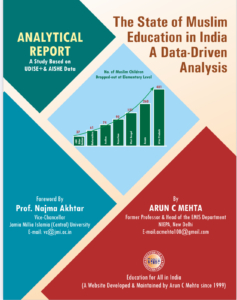AI-Powered Dropout Prediction in India
Case Studies from Kerala and Bihar
Introduction
India’s education system, serving over 247 million (2024-25) students in 1.47 million schools, struggles with dropouts (secondary, 11.5%), especially in rural areas, due to socio-economic and infrastructure issues. The Unified District Information System for Education Plus (UDISE+) provides essential data for AI-driven predictions to enable early interventions. This article analyses scalability through Kerala (advanced) and Bihar (developing) case studies, drawing from UDISE+ 2024-25 data. It outlines phased implementation, lessons from Andhra Pradesh’s Microsoft collaboration, and policy recommendations for the Ministry of Education (MoE), including provisions under Samagra Shiksha.
Review of Literature
AI for dropout prediction uses machine learning (ML) algorithms like random forests and neural networks, achieving 80-90% accuracy with variables such as attendance and socio-economic factors (Tete et al., 2022). Indian studies are limited, but the Andhra Pradesh-Microsoft project (2018-19) identified 19,500 at-risk students, reducing dropouts by 7% (Microsoft India, 2019). Global examples, like Morocco’s 88% accuracy model (El Mhouti et al., 2023), offer transferable insights. UNESCO (2022) emphasizes ethical AI to bridge rural-urban gaps in India.
Current Statistics: Kerala vs. Bihar
Kerala (Advanced State)
- Dropout Rates (2023-24, UDISE+): Primary/Upper Primary: 0.0 to 0.4%; Secondary: 4.8% (below national averages).
- Gross Enrolment Ratio (GER, 2024-25): Secondary: 98.7%.
- Digital Infrastructure: 99.7% + schools have computers, and 82% have internet connectivity in 2024-25.
Bihar (Developing State)
- Dropout Rates (2023-24, UDISE+): Primary: 2.9%; Upper Primary: 9.3%; Secondary: 6.9% (above national averages).
- GER (2024-25): Secondary: 51.1% & 50-60% in rural areas.
- Digital Infrastructure: 25.2% of schools have computers, and 84.8% have internet access. Perhaps the schools covered under the Man-with-Machine scheme will also be considered to have internet connectivity in 2024-25.
These disparities highlight Kerala’s AI readiness versus Bihar’s need for infrastructure upgrades amid Digital India’s growth (approx 954 million internet subscribers).
Implications for Phased Implementation
A three-phase rollout leverages Digital India’s momentum, addressing rural divides (40% offline households).
Phase 1: Pilot in Advanced States (1-2 Years, 2026-2027)
- Implications for Kerala: Rapid deployment focusing on nuanced factors; 85-90% accuracy achievable.
- Implications for Bihar: High dropout potential, but data gaps risk failure; delay inclusion.
- Start Strategies: Kerala: Integrate with KITE in 5,000 schools. Bihar: Urban feasibility studies in 500 schools.
- Prerequisites: Kerala: UDISE+ standardization and teacher training. Bihar: 30% connectivity upgrades.
Phase 2: Expansion to Semi-Urban and Rural States (3-5 Years, 2028-2032)
- Implications for Kerala: Full coverage; model refinement for transfer learning.
- Implications for Bihar: Cut dropouts by 10-15%; address data biases.
- Start Strategies: Kerala: Scale with partnerships. Bihar: Offline apps in 10,000 schools; NGO engagement.
- Prerequisites: Kerala: Ethical audits. Bihar: 50% rural connectivity and device distribution.
Phase 3: National Rollout (5-10 Years, 2033-2042)
- Implications for Kerala: Mentoring role; sustained low dropouts.
- Implications for Bihar: Half dropouts with investments.
- Start Strategies: National UDISE+ dashboard; cross-state sharing.
- Prerequisites: Kerala: Advanced AI features. Bihar: 80% coverage.
Microsoft-Andhra Pradesh Experience: Achievements and Challenges
Launched in 2015 using Azure ML, the project integrated UDISE+ data for predictions.
Achievements
- Pilot (2018-19): Identified 19,500 at-risk students in Visakhapatnam; uncovered patterns (e.g., infrastructure: 31% risk); interventions boosted enrollment by 5-7%.
- Expansion (2020-25): Covered 5 million students in 10,000+ schools; Vidyarthi Nestham app reduced dropouts by 7%; aligned with AI skilling.
Challenges
- Data inconsistencies required cleaning; infrastructure deficits delayed rollout.
- Privacy concerns under the DPDP Act; rural teacher adoption needed training (₹20 crore).
- Scalability demanded Azure upgrades for regional variations.
Lessons: Prioritizing data ethics and training is vital for Bihar.
Recommendations for the Ministry of Education and Provisions in Samagra Shiksha
The MoE must lead implementation by approving AI integration in national guidelines, collaborating with tech firms (e.g., Microsoft), and updating UDISE+ for real-time analytics. Key actions include forming an AI task force, ensuring DPDP Act compliance, and monitoring outcomes via annual reports. Budget 2025-26 emphasizes digital transformation, including an AI Centre of Excellence (CoE) in education under the IndiaAI Mission.
Provisions can be made in Samagra Shiksha, extended to 2025-26, which supports universal access, infrastructure, and teacher training. Specific integrations:
- ICT Component: Allocate ₹500-1,000 crore for AI tools, digital devices, and connectivity under BharatNet, enhancing platforms like DIKSHA for AI-generated insights.
- Teacher Training: Incorporate AI literacy modules in in-service programs, training 2 million teachers via DIKSHA (₹100-200 crore).
- Infrastructure Development: Fund school upgrades (e.g., computers, internet) in rural states like Bihar, integrating AI pilots.
- Equity and Inclusion: Use AI for targeted interventions in marginalized areas, aligned with SDG-4.1 goals.
Drawing from Budget 2025-26’s focus on AI skilling, these provisions can embed dropout prediction models seamlessly.
Concluding Observations
Kerala’s readiness contrasts with Bihar’s challenges, but Andhra Pradesh’s success shows AI’s potential to reduce the number of dropouts by 10-15% nationwide by 2035; this is expected to reduce the dropout rate significantly, especially at the secondary level. MoE leadership, via Samagra Shiksha provisions, is essential for equitable implementation, bridging digital divides, and fostering inclusive education.
Suggested Readings
- Tete, K., et al. (2022). A Systematic Literature Review on Student Dropout Prediction Models in Higher Education. Journal of Educational Data Mining.
- Aldowah, H., et al. (2021). Educational Data Mining and Learning Analytics for Student Success. International Journal of Educational Technology.
- UNESCO (2022). Artificial Intelligence in Education: Opportunities and Challenges in India. UNESCO Publications.
- UDISE+ 2024-25 Report. Ministry of Education, Government of India.
- Microsoft India (2019). AI for Education: Andhra Pradesh Case Study. Microsoft Case Studies.
- El Mhouti, A., et al. (2023). Predicting Student Dropout in Moroccan Higher Education Using Machine Learning. Journal of AI in Education.
- ASER Centre (2023). Annual Status of Education Report (Rural). Pratham.


